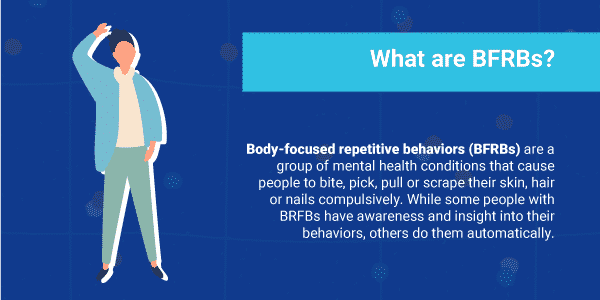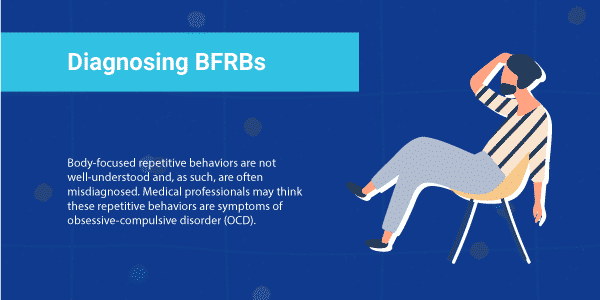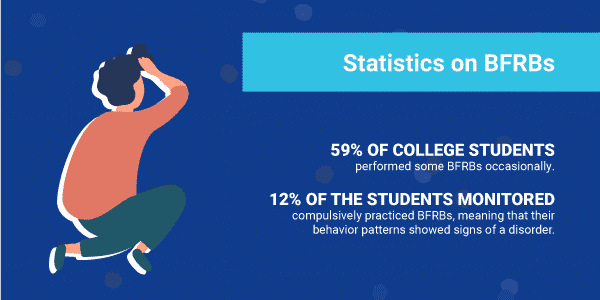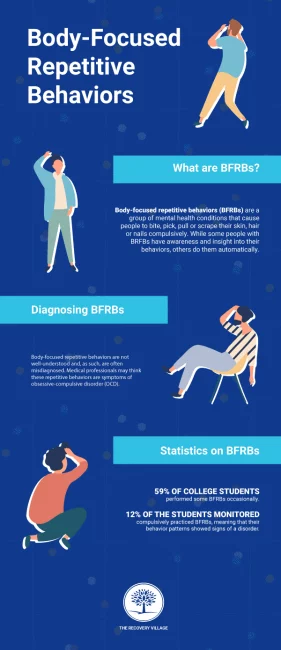Body-focused repetitive behaviors (BFRBs) are unintentionally harmful actions a person does to their body, including picking or biting the skin, lips and nails.
Body-focused repetitive behaviors (BFRBs) are a group of mental health conditions that cause people to bite, pick, pull or scrape their skin, hair or nails compulsively. While some people with BFRBs have awareness and insight into their behaviors, others do them automatically. BFRBs are often linked with disorders like anxiety or substance abuse. Treatment is essential for people with BFRBs, but many often hide evidence of these harmful actions and have trouble asking for help.
What Are BFRBs?
Body-focused repetitive behaviors are unintentionally harmful behaviors that can damage a person’s body. People who engage in BFRBs feel a strong urge to perform these behaviors. Some examples include hair pulling, skin picking and nail biting.
As these behaviors cause physical damage to the tissues, they can change the texture and appearance of the tissues. These changes can strengthen the urge to pick or prod the skin, continuing the cycle of BFRBs.
When a person takes part in these behaviors, they feel a brief period of calm or pleasure, as. these behaviors are often performed as a way to cope with emotional difficulties. However, individuals can also feel emotional distress and shame from the behaviors themselves.

Common Body-Focused Repetitive Behaviors
Body-focused repetitive behaviors are most commonly directed toward hair, skin, nails and the mouth. Some people struggle with more than one BFRB at the same time. The severity of these behaviors can vary from mild to disruptive. People with BFRBs make extensive efforts to hide their behaviors.
- Trichotillomania (Hair Pulling): Trichotillomania is a hair-pulling disorder. An individual with this disorder pulls hair from various parts of the body. Hair is most commonly pulled from the scalp, eyelashes and eyebrow areas. This behavior is generally more common in women than men.
- Excoriation Disorder (Skin Picking): Excoriation disorder is more commonly known as skin picking disorder. This disorder is defined by an almost irresistible urge to pick at one’s skin. An individual may pick at cuticles, sore spots, scabs and bumps on the skin. This behavior can lead to open wounds and sores all over the body.
- Onychotillomania (Nail Picking): Onychotillomania is a nail picking disorder. Onychotillomania symptoms include intense urges to peel, tear and pick at fingernails and toenails. Picking may be done with fingers or tools. Sometimes a person may completely tear off a nail while picking at it.
- Onychophagia (Nail Biting): Onychophagia is a BFRB characterized by a compulsion to bite one’s fingernails and toenails. This behavior is done in such an intense way that the biting becomes harmful to the nails and surrounding skin. Some people bite or remove their nails entirely.
- Dermatophagia (Skin Eating): Dermatophagia is a Greek word that translates to “skin eating.” People with this disorder have an intense urge to chew on their skin, mostly on their hands and fingers. This behavior can lead to bleeding and infections.
- Lip Biting (Lip Bite Keratosis): A lip biting disorder can lead to damaged lip tissues, causing lip bite keratosis. Keratosis is a thickened hardened part of the lip or mouth tissue, much like a callus on the skin. Repeated lip biting can cause bleeding, sores and inflammation.
- Cheek Biting (Cheek Keratosis): A cheek biting disorder is similar to chronic lip biting. People with this condition have a compulsive urge to bite and chew on the inside of their cheek. Repeated aggressive chewing can cause sores, tears and even cheek bite keratosis.
- Tongue Chewing: An individual with a tongue chewing disorder will compulsively chew on their tongue, usually along the sides. When swelling and sores develop, the changes can make an individual want to chew it even more often.
Related Topic: Excoriation treatment
What Causes Body-Focused Repetitive Behaviors?
Because very little research has been done on body-focused repetitive behavior, the causes of BFRBs are currently not well understood. However, BFRBs often occur with other mental health disorders, including impulse control, anxiety and obsessive-compulsive disorders. However, these disorders are not thought to cause BFRBs, but instead may occur alongside them.
Diagnosing BFRBs
Body-focused repetitive behaviors are not well-understood and, as such, are often misdiagnosed. Some individuals may dismiss these behaviors as bad habits. Medical professionals may think these repetitive behaviors are symptoms of obsessive-compulsive disorder (OCD). A mental health professional may not have the experience to know how BFRBs are distinct from OCD.
BFRBs are all categorized as obsessive-compulsive and related disorders. However, this is meant to be a broad category. OCD is related to but distinct from BFRBs. Body-focused repetitive behaviors are also different from intentional self-harm behaviors. BFRBs involve seeking pleasure or relief by acting on their compulsion. The physical damage done to body parts is not intended.

Statistics on Body-Focused Repetitive Behaviors
Occasional skin picking or other BFRBs are harmless habits for many people. In a study of 4,335 college students, more than 59 percent of them performed some BFRBs occasionally. While most people do not feel an uncontrollable urge to engage in BFRBs, the prevalence of diagnosable, compulsive BFRB patterns may be more common than most people think. Over 12 percent of the students monitored in the aforementioned study compulsively practiced BFRBs, meaning that their behavior patterns showed signs of a disorder.
BFRBs and Co-Occurring Disorders
Many individuals have just one body-focused repetitive behavior disorder. However, having one disorder increases a person’s chances of developing a second. A person who has a BFRB also has an increased chance of developing a mood or anxiety disorder as well.
According to a study in Annals of Clinical Psychiatry, individuals with more than one BFRB had more severe symptoms and impairment than individuals with just one BFRB. People with more than on BFRB tend to feel high levels of emotional distress. Because of this distress, these individuals need careful evaluation and support.

Treatment for Body-Focused Repetitive Behaviors
The success rate for body-focused repetitive behavior treatment tends to be low or inconsistent. Some of this low level of success may be due to misdiagnosis. Other poor results are likely due to a lack of long-term research. Therapists often help individuals with BFRBs by using therapy methods for anxiety or compulsive disorders.
Each person has different reasons and sensitivities that drive their behaviors. When a mental health professional provides individualized treatment, success is more likely. However, with little research to back up their efforts, professionals have few models of effective treatment. When BFRBs are better understood, treatments can become more targeted and effective.
In some cases, BFRBs may be driven by co-occurring mental health conditions like substance use disorder. By addressing all co-occurring disorders, clients are more likely to experience successful treatment outcomes.
The staff at The Recovery Village have the experience and expertise to treat co-occurring addiction and mental health disorders. Help and support are available 24 hours a day. Contact a representative at The Recovery Village today to learn more about our treatment programs for co-occurring BFRBs and substance use disorders.


BFRB.org. “Expert Consensus Treatment Guidelines, Body-focused repetitive behaviors.” 2016. Accessed March 23, 2019.
Grant, J. E., Leppink, E. W., Tsai, J., Chamberlain, S. R., Redden, S. A., Curley, E. E., Odlaug, B.L., Keuthen, N. J. “Does comorbidity matter in body-focused […] behavior disorders?” Annals of Clinical Psychiatry, 2016. Accessed March 23, 2019.
Houghton, D. C., Alexander, J. R., Bauer, C. C., Woods, D. W. “Body-focused repetitive behaviors: More prevalent than once thought?” Psychiatry Research, December 2018. Accessed March 23, 2019.
The Recovery Village aims to improve the quality of life for people struggling with substance use or mental health disorder with fact-based content about the nature of behavioral health conditions, treatment options and their related outcomes. We publish material that is researched, cited, edited and reviewed by licensed medical professionals. The information we provide is not intended to be a substitute for professional medical advice, diagnosis or treatment. It should not be used in place of the advice of your physician or other qualified healthcare providers.
